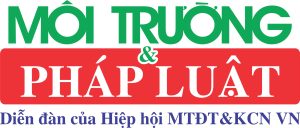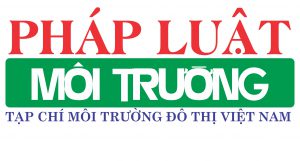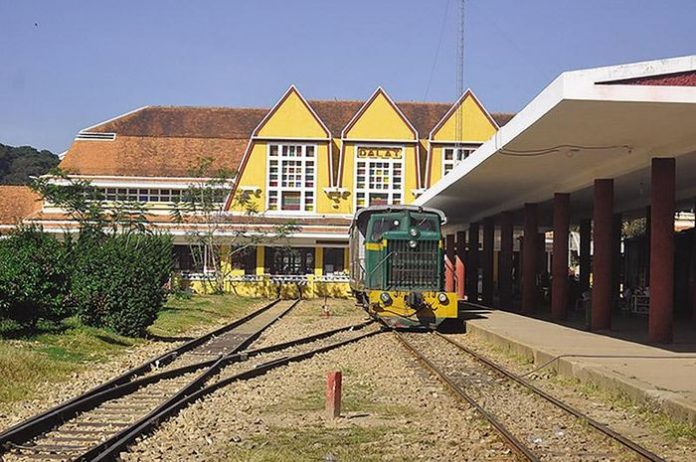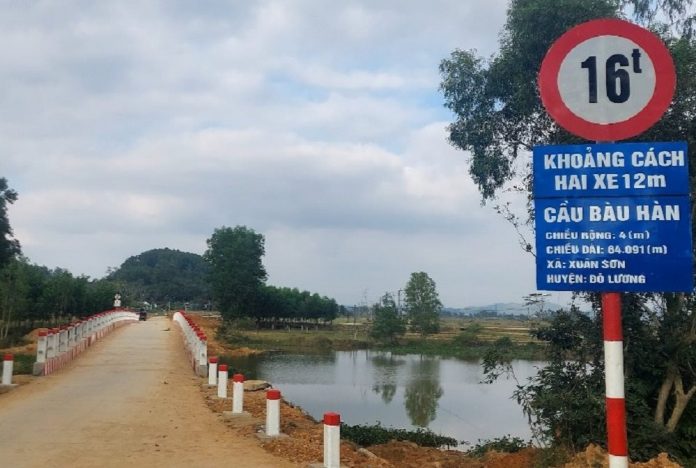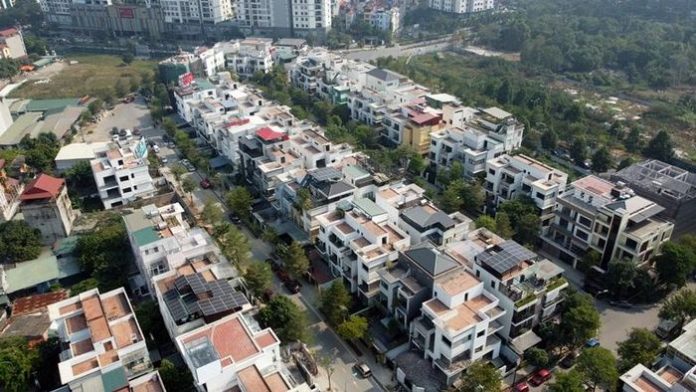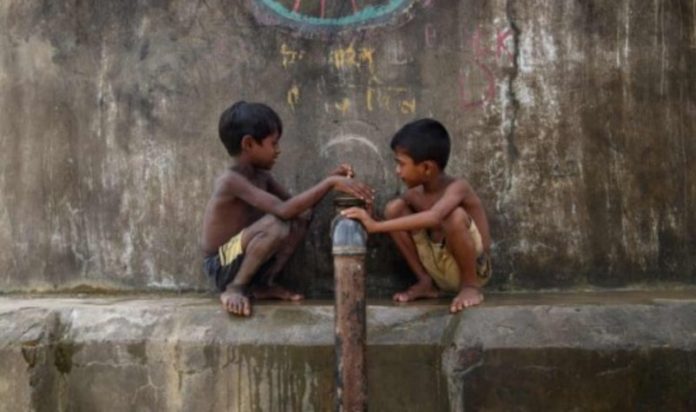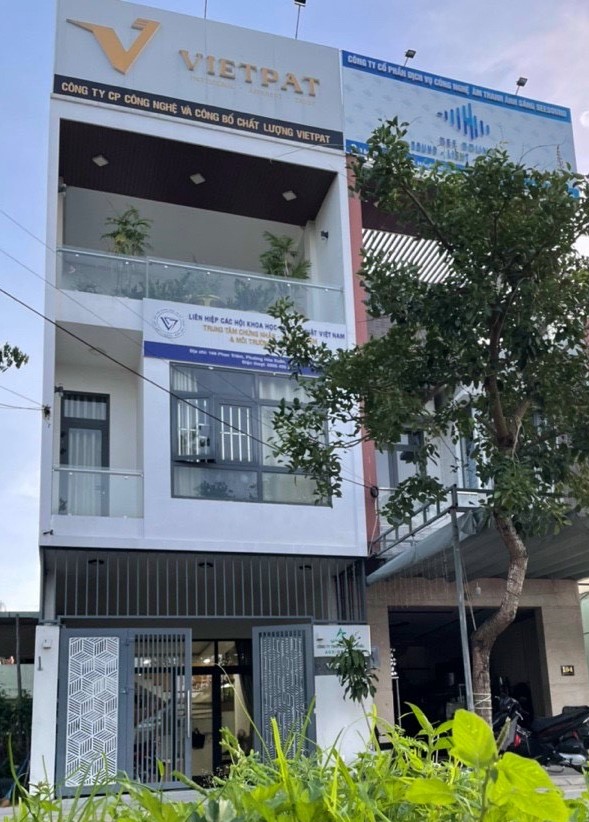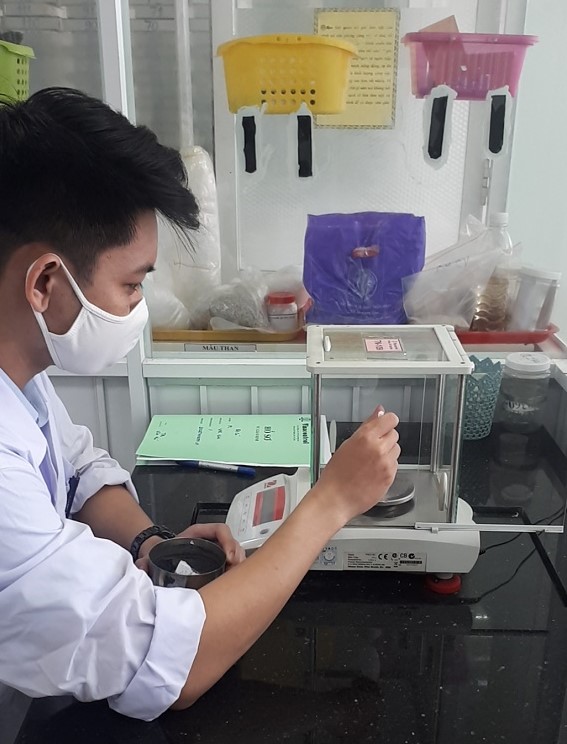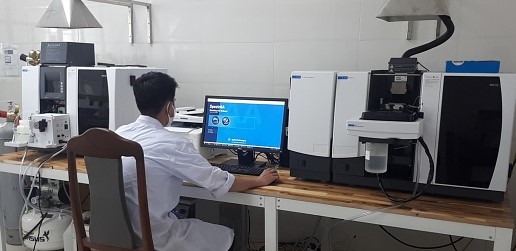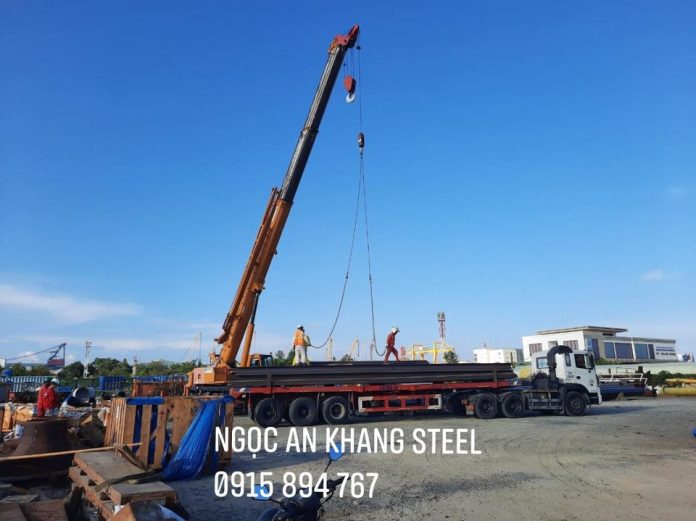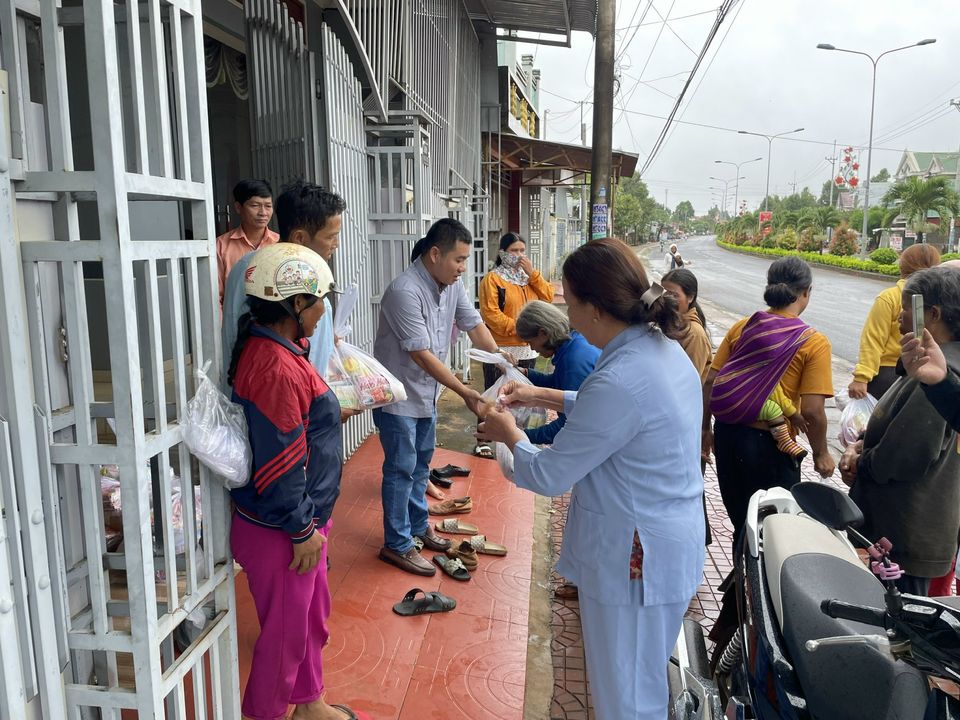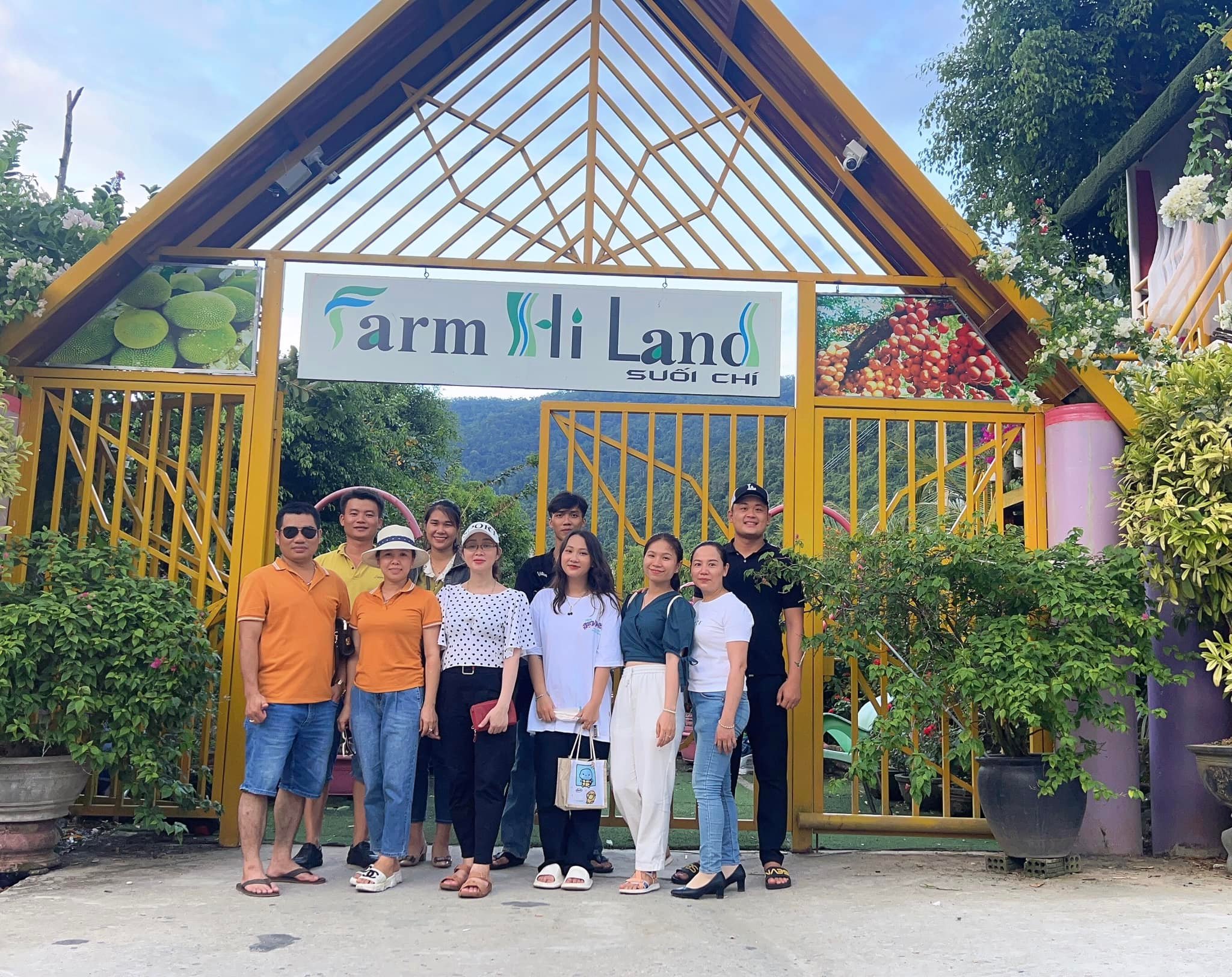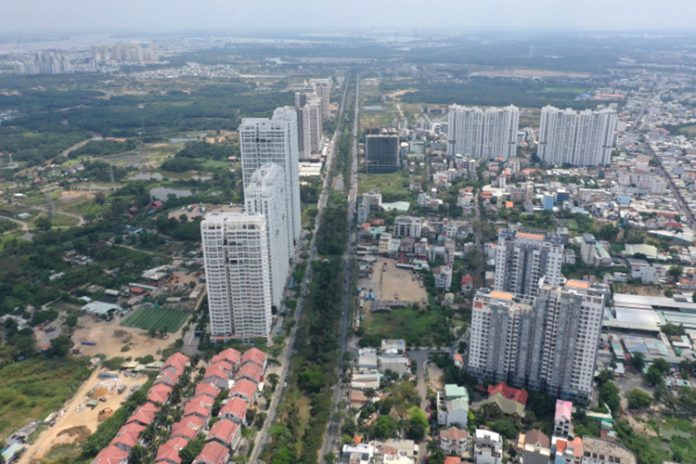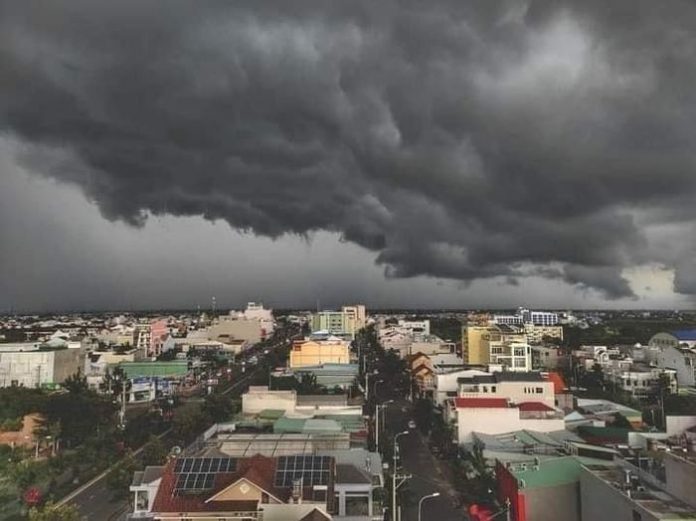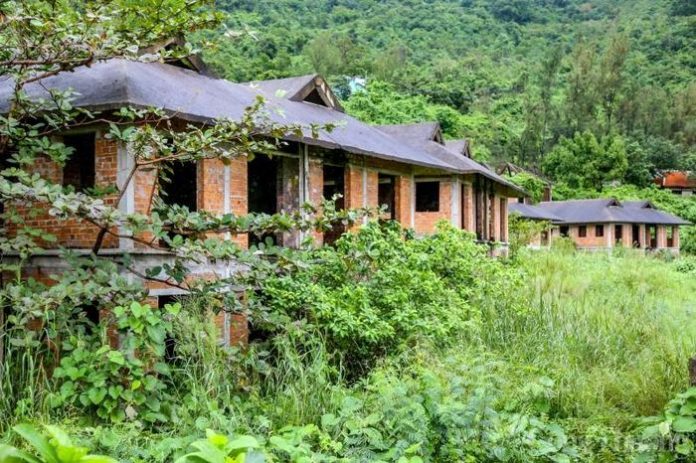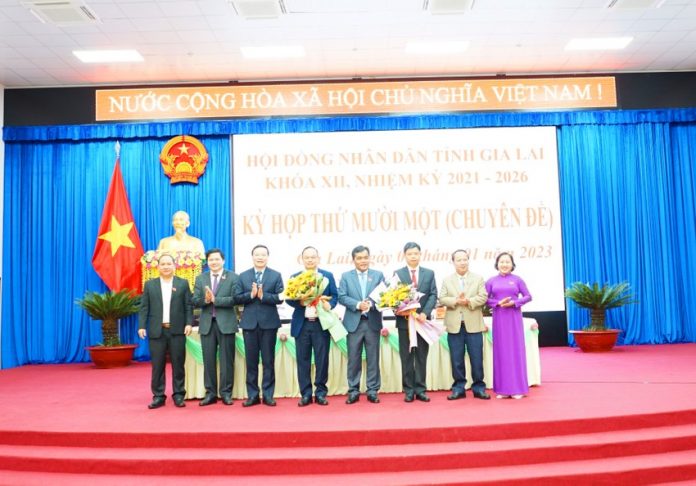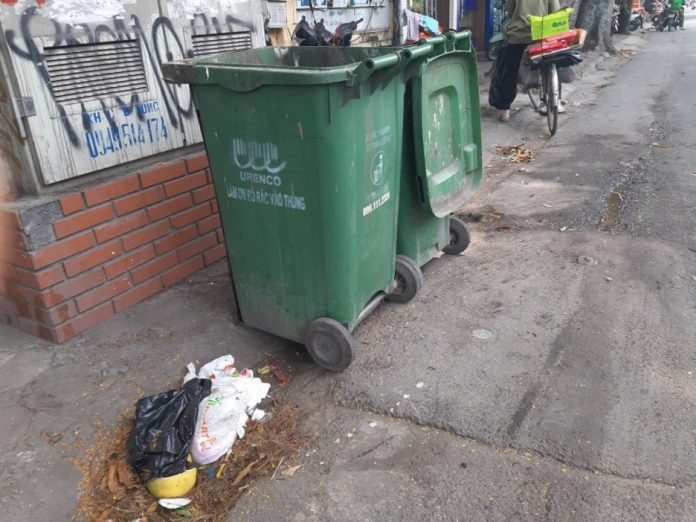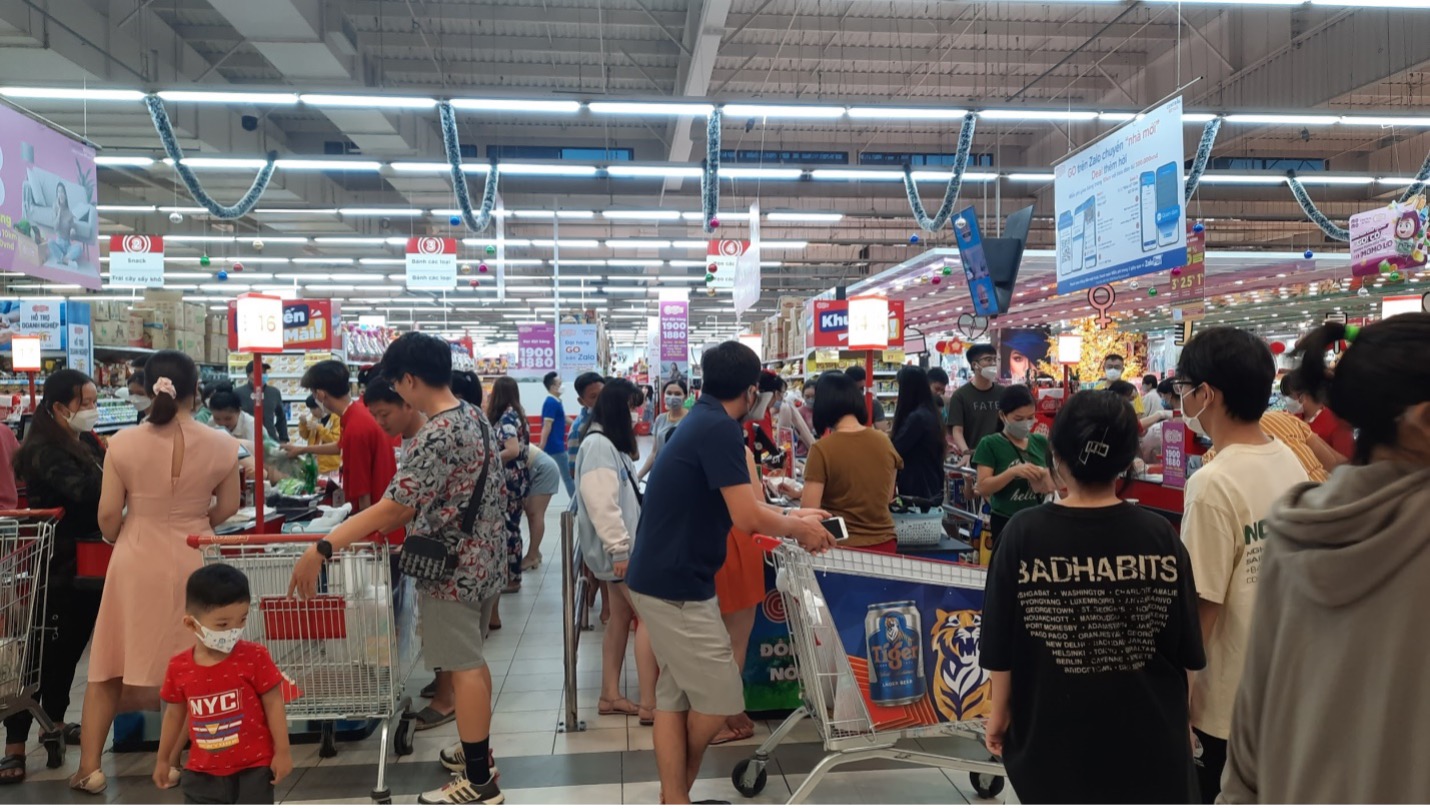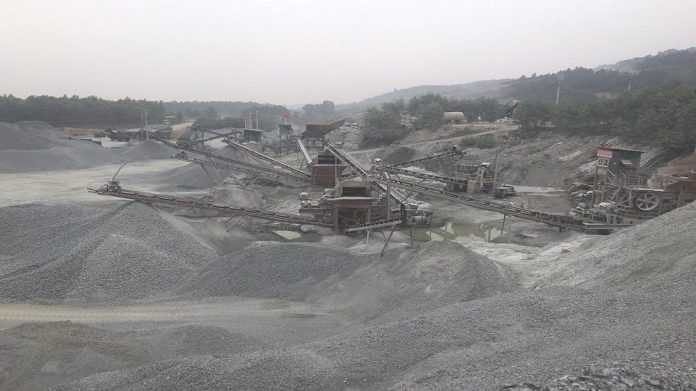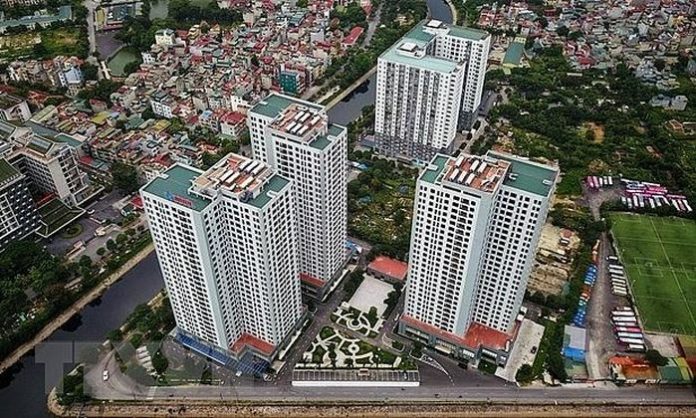Trân trọng giới thiệu tới quý độc giả Công bố quốc tế lĩnh vực môi trường số 48-2022 với những nội dung chính như sau:
Về quản lý môi trường
– Mức chì trong máu năm 2018/2019 so với năm 1987/1988 trong nghiên cứu KORA dựa trên dân số Đức
– Khung quản lý năng lượng tổng quát cho phương tiện xây dựng lai thông qua học tăng cường dựa trên mô hình
– Lợi ích kinh tế và môi trường của việc tích hợp giữa hấp thụ carbon và lưu trữ khí dưới lòng đất
– Phân tích lượng khí thải carbon và lượng khí thải carbon trong vòng đời của quy trình khí hóa plasma bùn đô thị
– Về việc triển khai lộ trình kinh tế tuần hoàn để quản lý chất thải điện tử: Đánh giá phản biện và phân tích đối với trường hợp của Nhà nước Cô-oét
– Quản lý mùi và vị sinh học: Từ nguồn nước, thông qua quy trình xử lý và hệ thống phân phối, đến người tiêu dùng
– Đánh giá quản lý chất thải rắn đô thị dựa trên chính sách bằng cách sử dụng hiệu quả sinh thái góc phần tư tương đối: Một nghiên cứu điển hình ở Malaysia
– Các lộ trình học tập để tham gia: Tìm hiểu các yếu tố thúc đẩy hành vi ủng hộ môi trường trong bối cảnh quản lý khu bảo tồn
Về môi trường đô thị
– Đánh giá định lượng tác động của sự ổn định và thời gian của các kiểu gió bề mặt đô thị đối với chất lượng không khí
– Microplastic trong nhà và vi khuẩn trong bụi phóng xạ khí quyển ở các ngôi nhà đô thị
– Đánh giá khả năng điều chỉnh pH trong quá trình đồng lên men kỵ khí chất thải đô thị loại carbohydrate: Vai trò của pH ở các điều kiện axit, trung tính và kiềm
– Khung phân tích khớp nối có hệ thống và cơ chế tương tác nhiều giai đoạn giữa hiệu quả sử dụng đất đô thị và sức tải sinh thái
– Giám sát đô thị về tình trạng kháng kháng sinh trong đợt bùng phát dịch COVID-19 thông qua giám sát nước thải
– Tiềm năng hấp thụ của thực vật và sự tồn tại của các methylsiloxan dễ bay hơi trong đất được cải tạo từ bùn thải
– Đánh giá về các phương pháp sinh học trong quản lý và chôn lấp chất thải rắn đô thị: Thu hồi tài nguyên và năng lượng
– Ảnh hưởng của việc cải thiện chất lượng không khí của các công viên đô thị đối với việc giảm thiểu PM2.5 và các kim loại nặng liên quan: Một nghiên cứu thực địa giám sát di động
– Ô nhiễm kim loại cũ được phản ánh trong hệ vi sinh vật đường ruột cá ở cửa sông đô thị hóa
Về môi trường khu công nghiệp
– Đánh giá tường thuật về nhiễm độc chì ở người do các hoạt động công nghiệp gây ra và các biện pháp tương thích với các hoạt động công nghiệp bền vững ở Cộng hòa Zambia
– Những tiến bộ gần đây trong việc giảm thiểu các hợp chất hữu cơ dễ bay hơi (VOC) và clo hóa-VOC bằng công nghệ plasma phi nhiệt: Đánh giá
– Chiến lược tiếp cận mới để cố định kim loại nặng và cấu trúc hệ vi sinh vật lâu dài cho đất bị ô nhiễm công nghiệp
– Đánh giá rủi ro sức khỏe của VOC nguy hiểm và mối liên hệ của nó với thời gian phơi nhiễm và các biện pháp bảo vệ cho công nhân ngành luyện cốc
– Sử dụng bụi lò hồ quang điện nguy hại trong ngành xây dựng: Hướng tiếp cận sản xuất sạch hơn
– Dịch vụ hóa đầu vào, chuỗi giá trị toàn cầu và giảm thiểu carbon: Góc nhìn đầu vào-đầu ra của ngành sản xuất toàn cầu
– Đặc điểm và cách xử lý nước thải mỹ phẩm do các ngành công nghiệp Brazil tạo ra: Đánh giá
– Bức tranh về hệ thống hỗ trợ ra quyết định dựa trên tập mờ cho ưu tiên công nghệ xử lý nước thải nhà máy lọc dầu: Chuyển đổi nền kinh tế nước tuần hoàn hướng tới ngành dầu khí
– Thúc đẩy phục hồi xanh: Chính sách tín dụng xanh trong ngành ô nhiễm nặng và rủi ro rớt giá cổ phiếu
Xin trân trọng giới thiệu!
QUẢN LÝ MÔI TRƯỜNG
1. Digital economy, energy efficiency, and carbon emissions: Evidence from provincial panel data in China
Science of The Total Environment, Volume 852, 15 December 2022, 158403
Abstract
Improving energy efficiency and lowering carbon emissions are of great importance to realize the “dual carbon” goal of carbon peak and carbon neutrality. Digital economy is a new engine of economic development, but whether or how it affects energy efficiency and carbon emissions are unclear. Utilizing panel data of China’s 30 provinces from 2012 to 2019, this study empirically explores the relationships among digital economy, energy efficiency, and carbon emissions. Meanwhile, from the perspective of energy efficiency, applying mediation models and panel threshold model, it analyzes the direct, indirect, and nonlinear influencing mechanisms of digital economy on carbon emissions. The results reflect that the development of digital economy in China intensifies carbon emissions. Energy efficiency serves as a vital partial mediator between the two. The enhancement of energy efficiency can lower carbon emissions. However, the development of digital economy is not conducive to improving energy efficiency, thereby, indirectly increasing carbon emissions. The mediating effect of energy efficiency accounts for 30.58 % of the total effect of digital economy on carbon emissions. Meanwhile, taking energy efficiency into account, the impact of digital economy on carbon emissions has a significant double-threshold effect and presents an N-shaped trend. [0.824, 0.912] is the optimal range of energy efficiency, within which the growth of the digital economy can empower carbon emission abatement to some extent. In addition, the expansion of population size, the coal-based energy consumption structure, and the industrial structure significantly increase carbon emissions. The improvements in living standards and environmental regulations can help to decrease carbon emissions, but the emission abatement effects are not significant. Those conclusions reveal the importance of optimizing the level and quality of digital economy and adopting differentiated digital economy development policies based on energy efficiency to achieve carbon emission reduction.
2. Blood lead levels in 2018/2019 compared to 1987/1988 in the German population-based KORA study
Environmental Research, Volume 215, Part 1, December 2022, 114184
Abstract
Introduction
Lead exposure remains of continuing concern due to its known and suspected impacts on human health and has been designated as a priority substance for investigation in human biomonitoring studies by the EU. The aims of this study were to measure blood lead levels (BLL) in a population based cohort of middle-aged individuals without major current exposures to lead, and to compare these to historical blood lead levels obtained thirty years earlier.
Methods
The population-based KORA study from 1984 to 2001 included inhabitants of the Augsburg Region, Germany. During 2018 to 2019, a subsample of these participants (KORA-Fit) was invited for interview regarding demographic and lifestyle factors, physical examination and blood withdrawal. Blood samples were stored at −80C prior to measurement of BLL via graphite furnace atomic absorption spectroscopy (GF-AAS). Descriptive and multivariable analyses were performed.
Results
BLLs were measured in 3033 eligible persons aged 54 to 73, establishing a geometric mean (GM) BLL of 24.8 μg/l in 2018/19. Of these, 555 (18%) had BLL above proposed 95th percentile reference values of the German Environment Agency. Only small differences were found in BLL stratified by sociodemographic categories, however regular smokers had higher GM BLL (26.1 μg/l) compared to never smokers (23.7 μg/l), and an increasing BLL with increased wine consumption was noted. For 556 individuals, BLLs (GM: 54.0 μg/l) reduced by 35% in men and 50% in women compared to levels in 1987/88 with only 1.4% of individuals having an unchanged or increased BLL.
Discussion
KORA-Fit provided contemporary normative data for BLL in a Western European population without major current sources of lead exposure. Mean BLLs have fallen since the 1980s using historical BLL data which is likely linked to the ban of leaded gasoline. Nevertheless, BLLs in this population remain elevated at levels associated with morbidity and mortality.
3. The establishment of Air Quality Health Index in China: A comparative analysis of methodological approaches
Environmental Research, Volume 215, Part 2, December 2022, 114264
Abstract
Background
The Air Quality Index (AQI) has been criticized because it does not adequately account for the health effect of multi-pollutants. Although the developed Air Quality Health Index (AQHI) is a more effective communication tool, little is known about the best method to construct AQHI on long time and large spatial scales.
Objectives
To further evaluate the validity of existing approaches to the establishment of AQHI on both long time and larger spatial scales.
Methods
By introducing 3 approaches addressing multi-pollutant exposures: cumulative risk index (CRI), supervised principal component analysis (SPCA), and Bayesian multi-pollutants weighted model (BMP), we constructed CRI-AQHI, SPCA-AQHI, BMP-AQHI and standard-AQHI on cardiovascular mortality in China from 2015 to 2019 at both the national and geographic regional levels. We further assessed the performance of the four methods in estimating the joint effect of multi-pollutants by simulations under various scenarios of pollution effect.
Results
The results of national China showed that the BMP-AQHI improved the goodness of fit of the standard-AQHI by 108.24%, followed by CRI-AQHI (5.02%), and all AQHIs performed better than AQI, consistent with 6 geographic regional results. In addition, the simulation result showed that the BMP method provided stable and relatively accurate estimations of the short-term combined effect of exposure to multi-pollutants.
Conclusions
AQHI based on BMP could communicate the air pollution risk to the public more effectively than the current AQHI and AQI.
4. Interactions among electricity consumption, disposable income, wastewater discharge, and economic growth: Evidence from megacities in China from 1995 to 2018
Energy, Volume 260, 1 December 2022, 124910
Abstract
The 2030 Agenda for Sustainable Development clarifies Goal 11 to make cities sustainable. Understanding the interacting relationships is the key to effective policies and addressing sustainable urban development. This paper aims to expand the research on the interactions between electricity consumption, disposable income, wastewater discharge, and economic growth. We apply the fully modified ordinary least square (FMOLS) and vector error correction model (VECM) in a panel of 14 Chinese megacities from 1995 to 2018. The main conclusions are as follows: (1) The decrease in efficiency of electricity consumption in these cities will reduce average disposable income and increase the intensity of wastewater discharge; (2) In turn, the increase of wastewater discharge intensity will also reduce the power efficiency; (3) The development of these cities is still at the cost of polluting the water environment; (4) There is a sign of decoupling of economic growth and electricity consumption in these cities; (5) The Environmental Kuznets Curve can be established in these cities for industrial wastewater discharge. Accordingly, we propose policy implications in avoiding negative interactions that hinder sustainable development.
5. A generalized energy management framework for hybrid construction vehicles via model-based reinforcement learning
Energy, Volume 260, 1 December 2022, 124849
Abstract
Hybrid construction vehicles (HCVs) have more specific tasks and highly repetitive patterns than on-road vehicles. Consequently, they are more suitable for model-based energy management. However, distinctions between work cycles result in adverse scenarios for generalizing model-based energy management. In this study, we solve this problem by proposing a generalized strategy using a model-based reinforcement learning framework. The generalized design highlights three aspects: 1) long-term stability, 2) self-learning ability, and 3) state transition model reuse. A reward function with a trend term is proposed to avoid the cumulative errors between operation cycles and improve the long-term stability of learning. In addition, Gaussian process regression is leveraged to approximate the value function, thereby reducing the computational load and improving the learning efficiency. To further enhance the reusability of the environmental model, a modelling method based on the Gaussian mixture model is put forward. Finally, a generalized HCV energy management framework that includes offline and online learning is designed, where a pre-learning model and an approximation function are adopted for reuse and dynamic learning. Simulation results demonstrate the superiority of the proposed framework to conventional model-based methods in terms of stability, generality, and adaptability, accompanied by a reduction of 5.9% in fuel consumption.
6. Tracking embodied energy flows of China’s megacities via multi-scale supply chains
Energy, Volume 260, 1 December 2022, 125043
Abstract
Urban energy requirements not only involve energy supplies within self-boundaries, but also impose huge demands via domestic and global supply chains. By constructing a multi-scale input-output model, this study depicts embodied energy uses of China’s four megacities including urban, national, and global scales. The total embodied energy requirements of Beijing, Tianjin, Shanghai, and Chongqing are 8576.61, 6309.56, 11448.19, and 6941.43 PJ, respectively. Shanghai has the highest embodied energy use per capita (464.24 GJ), followed by Tianjin (447.49 GJ), Beijing (390.91 GJ), and Chongqing (220.78 GJ). Fixed capital formation accounts for above 70% of local energy requirements in Chongqing as the leading final demand category, while Urban household consumption in Shanghai accounts for nearly 40% of its local energy requirements. More than 20% of energy requirements in Beijing are imported from foreign economies, while about 10% of embodied energy uses in Shanghai are exported to other countries, mainly due to their location advantages and economic openness. Through depicting energy requirements of urban economies, this study is essential to recognize visible and embodied energy uses along multi-scale supply chains and address cross-boundary potentials of energy saving at urban, national, and global scales.
7. Economic and environmental benefits of the integration between carbon sequestration and underground gas storage
Energy, Volume 260, 1 December 2022, 125094
Abstract
It is critical for China to promote the substitution of coal with natural gas (NG), and the development of carbon sequestration (CS) technology to achieve its carbon neutrality goal by 2060. Underground gas storage (UGS) employing CS technology is an important choice suitable for NG development in large scale and carbon neutral goal requirements. Unfortunately, to date China’s UGS has not yet adopted CS technology. This paper focuses on the operation optimization scheme of UGS with CS technology as well as the economic benefits and carbon emission reduction effects of this technology. Firstly, a proxy model with consideration of CS is constructed to improve the operation mode of UGS, and then the operation parameters concerning the dual objective function of maximizing revenue and CS volume is optimized. Based on the range of geological parameters in China, Monte Carlo simulation is used to simulate 100,000 scenarios. The results show that by 2050 the total UGS revenue in China would reach 22.013 billion to 39.423 billion US dollars, and the total CS volume would reach 26.374 million to 54.018 million tons, approximately the total carbon emissions of China’s Qinghai Province in 2018. Finally, policy recommendations are provided.
8. Life cycle water footprint and carbon footprint analysis of municipal sludge plasma gasification process
Energy, Volume 261, Part B, 15 December 2022, 125280
Abstract
In this study, the life cycle carbon footprint and water footprint of municipal sludge-to-hydrogen conversion by plasma gasification were analyzed. Results show that the carbon footprint of the process is 950 kg/GJ, and the water footprint is 3.21 m3/GJ in the basic scenario. The carbon footprint of the Rectisol units was the highest, accounting for 24.04%. Low-pressure nitrogen can be used for acid gas desorption to reduce carbon emissions. The life cycle water consumption comes mainly from electricity consumption (1.93 m3/GJ) and the cooling process (0.610 m3/GJ). Optimizing the electricity structure reduces the water footprint. The effects of 24 scenarios were investigated using sensitivity analysis. It was found that improving hydrogen efficiency or reducing electricity consumption can improve environmental performance. In addition, regional differences in the electricity structure can lead to differences in results. The carbon footprint of hydro-dominated regions (Sichuan, Qinghai, Tibet, and Yunnan) was only 20% of the basic scenario, while the water footprint was approximately threefold. This work presents the values of carbon emissions and water consumption within the specific scenario of municipal sludge-to-hydrogen by the plasma gasification process, providing support for its further development.
9. On the implementation of the circular economy route for E-waste management: A critical review and an analysis for the case of the state of Kuwait
Journal of Environmental Management, Volume 323, 1 December 2022, 116181
Abstract
Electronic waste (e-waste) has become one of the major causes of environmental concerns due to its large volume, high generation rate and toxic environmental burdens. Recent estimates put e-waste generation at about 54 million tonnes per annum with figures reaching approximately 75 million tonnes per annum by 2030. In this manuscript, the state-of-the-art technologies and techniques for segregation, recovery and recycling of e-waste with a special focus on the valorisation aspects of e-plastics and e-metals which are critically reviewed. A history and insight into environmental aspects and regulation/legislations are presented including those that could be adopted in the near future for e-waste management. The prospects of implementing such technologies in the State of Kuwait for the recovery of materials and energy from e-waste where infrastructure is lacking still for waste management are presented through Material Flow Analysis. The information showed that Kuwait has a major problem in waste accumulation. It is estimated that e-waste in Kuwait (with no accumulation or backlog) is generated at a rate of 67,000 tpa, and the imports of broadcasting electronics generate some 19,428 tonnes. After reviewing economic factors of potential recovered plastics, iron and glass from broadcasting devices in Kuwait as e-waste, a total revenue of $399,729 per annum is estimated from their valorisation. This revenue will open the prospect of ventures for other e-waste and fuel recovery options as well as environmental benefits and the move to a circular economy.
10. Management of biogenic taste and odour: From source water, through treatment processes and distribution systems, to consumers
Journal of Environmental Management, Volume 323, 1 December 2022, 116225
Abstract
Biogenic taste and odour (T&O) have become a global concern for water utilities, due to the increasing frequency of algal blooms and other microbial events arising from the combined effects of climate change and eutrophication. Microbially-produced T&O compounds impact source waters, drinking water treatment plants, and drinking water distribution systems. It is important to manage across the entire biogenic T&O pathway to identify key risk factors and devise strategies that will safeguard the quality of drinking water in a changing world, since the presence of T&O impacts consumer confidence in drinking water safety. This study provides a critical review of current knowledge on T&O-causing microbes and compounds for proactive management, including the identification of abiotic risk factors in source waters, a discussion on the effectiveness of existing T&O barriers in drinking water treatment plants, an analysis of risk factors for biofilm growth in water distribution systems, and an assessment of the impacts of T&O on consumers. The fate of biogenic T&O in drinking water systems is tracked from microbial production pathways, through the release of intracellular T&O by cell lysis, to the treatment of microbial cells and dissolved T&O. Based on current knowledge, five impactful research and management directions across the T&O pathway are recommended.
11. Policy-driven municipal solid waste management assessment using relative quadrant eco-efficiency: A case study in Malaysia
Journal of Environmental Management, Volume 323, 1 December 2022, 116238
Abstract
Despite studies encouraging sustainable waste management, most municipal wastes remain in landfills, particularly in developing countries. Lack of holistic planning and national policy alignment might impair the waste management facility implementation. Policy-driven waste treatment scenarios should be designed to strongly link to the local conditions when assessing the eco-efficiency impacts of the waste management system. Taking Malaysia as a case study, a relative quadrant life cycle eco-efficiency indicator is developed to investigate the eco-efficiency of waste treatment scenarios. The relative quadrant life cycle eco-efficiency indicator depicts the eco-efficiency of various waste management scenarios. Compared with Scenario S1 – business-as-usual (i.e., 71.5% open landfill, 10% sanitary landfill, 1% composting, 17.5% recycling), five waste treatment scenarios (S2–S6) are designed based on Malaysia’s existing and future policy targets. Scenario S5 (15.5% sanitary landfill, 22.25% composting, 22.25% anaerobic digestion, 40% recycling) and Scenario S6 (5% sanitary landfill, 22.25% composting, 22.25% anaerobic digestion, 40% recycling, 10.5% incineration) demonstrate that the 40% recycling rate is 32.9–33.6 times more environmentally favorable and 10–20% more economically viable than business-as-usual. Another four scenarios (NS1-NS4) are designed to investigate zero waste in landfills and the need to implement incineration or material recovery. Scenario NS3 suggests increasing incineration capacity to 33% could be an option should incineration is implemented. Adopting home or centralized windrow composting and increasing 2.5–5.5 times of current Feed-in Tariff rates are recommended to improve the eco-efficiency of the waste treatment scenarios. This study could facilitate policymakers to set waste minimization targets and incentives through various scenarios via sensitivity and comparative analyses.
12. Learning pathways for engagement: Understanding drivers of pro-environmental behavior in the context of protected area management
Journal of Environmental Management, Volume 323, 1 December 2022, 116204
Abstract
The participation of local communities in management decisions is critically important to the long-term salience and therefore, success, of protected areas. Engaging community members in meaningful ways requires knowledge of their behavior and its antecedents, particularly values. Understanding how learning influences cooperation in conservation initiatives is also fundamentally important for supporting decisions being made about public lands. However, there is little empirical evidence of how learning from different information sources works in conjunction with values that shape behavior. Using data from a household survey of residents living in the Denali region of Interior Alaska, U.S, we estimated a two-step structural equation model to understand the psychological reasons why stakeholders made decisions to collectively benefit the environment. Results showed that more diverse pathways by which learning occurred were instrumental in explaining why residents performed pro-environmental behaviors over the past year. Additionally, values that reflected the goals of eudaimonia influenced the transfer and negotiation of knowledge exchange among stakeholders as a correlate of behavior. Environmental concern and personal norms were positively associated with reported behaviors operationalized as social environmentalism and living in an environmentally conscientious manner, whereas environmental concern and willingness to pay for protected area management positively influenced civic engagement. We argue that broadening the range of learning spaces and considering a more diverse array of values in communities surrounding protected areas will encourage daily lifestyle changes, social interactions to support environmentalism, and more robust, pluralistic forms of public engagement in natural resource management.
13. Resilience assessment and management: A Review on contributions on process safety and environmental protection
Process Safety and Environmental Protection, Available online 26 December 2022
Abstract
Promoting the downscaling and integration of zonal management and control of various environmental pollution sources is an effective way to systematically deal with the current high-intensity and complex environmental problems. Through single-factor and comprehensive pollutant emission intensity evaluation and cluster analysis, we built a full-coverage and cross-scale environmental spatial management and control system for pollution sources, then proposed environmental zoning patterns and pollution control strategies at three scales in the Yangtze River Delta (YRD), China. At the grid scale, the reclassified 7 types of pollution source spaces can be divided into 5 levels based on pollution emission intensity, and the most urgent environmental control subjects can be determined accordingly. Up to the county scale, combined with emission intensity and regional functions, 305 counties can be divided into 5 control intensity zones, which directly correspond to different environmental control intensity, requirements and policies. Finally, at the city scale, 41 cities can be clustered into 7 pollution control zones, which are classified and named as the three-level form of geographic location, development orientation and pollution source characteristics. Fully using the zoning units at different scales of cities, counties and grids can break the limitation of inherent administrative boundaries and allow environmental integration policies to be implemented across departments and regions, also let differentiated policies be more accurately implemented to different administrative levels and pollution source, and then truly improve the efficiency of environmental management.
14. Urban land expansion, fiscal decentralization and haze pollution: Evidence from 281 prefecture-level cities in China
Journal of Environmental Management, Volume 323, 1 December 2022, 116198
Abstract
Urban land expansion will influence aspects of economy and society, including the quality of the urban environment. This study aims to examine the impacts of urban land expansion in China on haze pollution under the fiscal decentralization system using the spatial Durbin model. Urban land expansion is measured using two dimensions of urban land expansion, namely, intensity and orderliness of the structure of urban land expansion. The results reveal that urban haze pollution in China exhibits significant positive spillover characteristics, which manifest as “high–high” and “low–low” characteristics of spatial agglomeration. In general, improving the expansion intensity of urban land and the orderly structure of urban land expansion can reduce haze pollution in local and surrounding areas. With the improvement of the degree of fiscal decentralization, the positive effect of an orderly urban land structure in reducing haze pollution will be weakened. The above-mentioned influences depict distinct heterogeneities at the levels of city size, type, and location.
15. Save the environment, get financing! How China is protecting the environment with green credit policies?
Journal of Environmental Management, Volume 323, 1 December 2022, 116178
Abstract
Green credit policy (GCP) can achieve economic growth and environmental conservation, notably by lowering air pollutants (PM2.5). Green credit is a significant component of China’s green financing for environmental regulation and achieving carbon neutrality. In this paper, to understand the causal relationship between GCP and PM2.5, we apply a bootstrap full-sample Granger causality test, parameter stability test, and quantile-on-quantile test for the period between 2003:M01 to 2019:M12. The result shows a bidirectional relationship and reveals that GCP has varied environmental implications in its early and mature stages because of a low percentage of green credit and a lack of motivation for financial institutions. In the long run, GCP and PM2.5 interaction confirm the favorable effects of GCP on PM2.5 as the green credit system improves. For robustness, we used quantile-based granger causality to evaluate the causative link between GCP and PM2.5. In light of the findings, this research advises legislative reforms and stresses the relevance of green credit in improving air quality. This study adds additional evidence that air pollution affects green credit policies. Air quality being a leading indicator helps firms anticipate changes in bank credit preferences and alter financing techniques.
MÔI TRƯỜNG ĐÔ THỊ
1. Hydrothermal carbonization of kitchen waste: An analysis of solid and aqueous products and the application of hydrochar to paddy soil
Science of The Total Environment, Volume 850, 1 December 2022, 157953
Abstract
Hydrothermal carbonization (HTC) technology can potentially be used to safely and sustainably utilize kitchen waste (KW). However, the characteristics of HTC solid products (hydrochar) and aqueous products (HAP) based on different types of KW have not yet been clarified. Here, four types of KW, cellulose-based (CL), skeleton-based (SK), protein-based (PT), and starch-based (ST) KW, were used for HTC at 180 °C, 220 °C, and 260 °C. The basic physicochemical properties and structures of hydrochars and HAP were analyzed, and the effects of different hydrochars on rice growth were characterized. HTC decreased the H/C and O/C of KW. All hydrochars were acidic (3.12 to 6.78) and the pH values increased with the HTC temperature, while high HTC temperature reduced the porosity of hydrochars. HTC promoted the enrichment of total carbon (up to 78.1 %), total nitrogen (up to 62.6 %), and total phosphorus (up to 171.6 %) in KW. More carbon (60.7–88.0 %) and nitrogen (up to 87.4 %) were present in the hydrochars than in the HAP. The relative content of C1s increased and O1s decreased in CL and ST hydrochars as the HTC temperature increased, while the opposite pattern was observed for SK and PT hydrochars. The dissolved organic matter (DOM) of different hydrochars and HAP were mainly humus-like substances. The biodegradability of the DOM in HAP was often higher than the corresponding hydrochar, and their DOM biodegradability increased with the HTC temperature. The content of heavy metals from different hydrochars did not exceed the relevant thresholds of fertilizer standards. Rice grain yield increased by 3.7–11.1 % in the hydrochar treatments without phosphate fertilizer addition compared with the control treatment. The results of this study provide new theoretical and empirical insights into the potential for HTC technology to be used for the recycling of KW and its products in the agricultural environment.
2. Quantitative evaluation of impacts of the steadiness and duration of urban surface wind patterns on air quality
Science of The Total Environment, Volume 850, 1 December 2022, 157957
Abstract
The complexity and heterogeneity of urban land surfaces result in inconsistencies in near-surface winds, which in turn influence the diffusion and dispersion of air pollutants. In this study, we classified urban surface wind fields, quantified their steadiness, duration, and influence on air quality using hourly wind observations from 50 meteorological stations, as well as hourly PM2.5 and NO2 concentrations from 18 monitoring stations during 2017–2018 in Shenzhen, a mega city in southern China. We found that the K-means clustering technique was reliable for distinguishing surface wind patterns within the city. Urban surface-wind patterns greatly affected pollutant concentrations. When dominated by calm, northerly wind, high PM2.5/NO2 concentration episodes occurred more frequently than those during other surface wind patterns. The urban surface transport index (USTI) was used to quantify the steadiness of surface wind classes. High pollutant concentrations were present during both high wind speed periods with a large USTI, indicating external pollutant transport, and during low wind speed periods with a small USTI, indicating pollutant accumulation. The threshold durations for surface wind fields (TDSWF) was proposed to quantify the impacts of surface wind persistence on air quality. We found that poor air quality occurred during the first several hours of a dominant wind pattern, indicating that transitions between wind patterns should be a particular focus when assessing air-quality deterioration. USTI and TDSWF are potentially applicable to other urban areas, owing to their clear definitions and simple calculation. In combination with wind speeds, these indices are likely to improve air quality forecasting and strategic decisions on air pollution emergencies, based on long time series of multiple wind and pollutant concentration observations.
3. Collection and transportation system construction of potentially viral municipal solid waste during the COVID-19 pandemic in China
Science of The Total Environment, Volume 851, Part 2, 10 December 2022, 157964
Abstract
The transmission route of COVID-19 through municipal solid waste (MSW) has been confirmed and receives increasing attention. Potentially viral municipal solid waste (PVMSW) refers to the domestic waste generated by risky areas and epidemic-related populations under a major epidemic in their daily lives or in activities that provide services for their daily lives. For its potential infectivity, PVMSW should be properly collected and transported. This study aimed to standardize the collection and transportation of PVMSW and proposed specific construction schemes of PVMSW collection and transportation systems for three situations which were city-wide lockdown status, medium and high-risk area, and home quarantine separately. In the cases of city-wide lockdown status and home quarantine, PVMSW collection and transportation systems were constructed qualitatively with the examples of Wuhan and Shanghai respectively, and in the case of medium and high-risk area, the systems were constructed quantitatively through the development of a waste collection and transportation costs model. To reduce the risks of virus transmission during the collection and transportation process, the collection and transportation links should be minimized. For the disposal of PVMSW, medical waste treatment facilities and MSW incineration plants should be prioritized. Furthermore, the results showed that the total number of people and the transfer capacity of MSW transfer facility were the two main influencing factors for the selection of PVMSW collection and transportation systems in medium and high-risk area. This article could help manage MSW for preventing virus transmission during the COVID-19 pandemic or similar future epidemics.
4. Indoor microplastics and bacteria in the atmospheric fallout in urban homes
Science of The Total Environment, Volume 852, 15 December 2022, 158233
Abstract
Humans may be exposed to microplastics (MPs) through food, drink, and air. Although several studies have examined indoor environmental MPs, none have yet compared atmospheric MP and bacterial deposition characteristics among rooms in homes. We investigated indoor airborne MPs and bacteria in five room types (bedroom, dining room, living room, bathroom, and study) based on the duration of usage of each room. We identified synthetic polymers (23,889 MP particles of 21 types) and bacterial communities (383 genera belong to 24 phyla) collected through atmospheric deposition in various rooms of 20 homes. The abundance and composition of MPs are related to the duration of usage, human activities, goods, cleanliness, and the composition of occupants (family members) in households. In addition, the homes of elderly families (age 68–81 years) showed higher bacterial concentrations than those of young families (age 28–35 years), indicating that age markedly affects the structure of household microbiota. Furthermore, a significant correlation between MP concentration and bacterial community structure was observed. The abundances of polyamide (PA), polyurethane (PU), and polyethylene (PE) showed positive correlations with the relative abundances of major bacterial phyla. Taken together, our results suggest that various rooms in the home exhibit distinct MP abundances and bacterial structures that may be affected by age, cleanliness, and human activities.
5. Different functional areas and human activities significantly affect the occurrence and characteristics of microplastics in soils of the Xi’an metropolitan area
Science of The Total Environment, Volume 852, 15 December 2022, 158581
Abstract
Microplastics (MPs) pollution in the environment has become a global hotspot, but there is insufficient research on MPs in soils of large cities. This study investigated the pollution status of MPs in soils in different functional areas (commercial, tourist, industrial, and residential areas) of the Xi’an metropolitan area. The average abundances of MPs were 2218 items/kg in Xi’an city, 1329 items/kg in Xianyang city and 1400 items/kg in Yangling city. All MPs presented different shapes and were dominated by fragment and fiber. The 0–0.5 mm MPs accounted for the largest proportion. Polyethylene terephthalate (PET) was the predominant polymer type for MPs. The results showed that the soil in the Xi’an metropolitan area was polluted by MPs, with the pollution of MPs in Xi’an city being more severe than other two cities. This could be related to the advanced urbanization and industrialization process. Moreover, industrial and tourist areas had frequent industrial and human activities, so their MPs pollution was the worst. In addition, residential areas and some commercial areas far away from pollution sources had lower pollution levels and a more uniform distribution of MPs. This study may provide data and valuable reference for the investigation of soil MPs pollution in the Xi’an metropolitan area.
6. Evaluation of pH regulation in carbohydrate-type municipal waste anaerobic co-fermentation: Roles of pH at acidic, neutral and alkaline conditions
Science of The Total Environment, Volume 853, 20 December 2022, 158327
Abstract
This study investigated and evaluated the roles of acidic (pH 4.0), neutral (pH 7.0) and alkaline (pH 10.0) in anaerobic co-fermentation of sewage sludge and carbohydrate-type municipal waste. CO2, CH4 and H2 are produced in acidic, neutral and alkaline fermentation, respectively. The neutral co-fermentation contained the vast number of aqueous metabolites as total of 22.12 g/L, with the advantage of over 50 % biodegradable components in extracellular polymeric substance and over 80 % hydrolysis rate. Acidic and alkaline pH facilitated ammonia release, with the max concentration of 0.46 g/L and 0.44 g/L, respectively. Microbial analysis indicated that pH is the key parameter to impact microbial activity and drive microbial community transition. The high abundance of Lactobacillus, Bifidobacterium and Clostridium was associated with harvest of ethanol, lactic acid and acetate in acidic, neutral and alkaline fermentation. Meanwhile, the floc feature showed better dewaterability (zeta potential −8.48 mV) and poor nutrient convey (distribution spread index 1.03) in acidic fermentation. In summary, acidic and alkaline fermentation were prioritised for targeted spectrum. Neutral fermentation was prioritised for high production. This study presented an upgraded understanding of the pH role in fermentation performance, microbial structure and sludge behaviour, which benefits the development of fermentation processing unit.
7. A systematic coupling analysis framework and multi-stage interaction mechanism between urban land use efficiency and ecological carrying capacity
Science of The Total Environment, Volume 853, 20 December 2022, 158444
Abstract
Since urban land use efficiency (ULUE) bridges urbanization and economic efficiency while ecological carrying capacity (ECC) is the basic natural endowments support, the coupling coordination degree (CCD) between ULUE and ECC represents a combination of resource-intensive and environment-friendly, which can serve as an effective tool to evaluate sustainable development. We first quantified ULUE and ECC by super-efficiency DEA, DPSIR framework, and entropy-TOPSIS from a coupling perspective, attempting to compensate for the lack of clarity regarding urban sustainability constraint factors in the holistic perspective. On this basis, we formulate an integrated coupling coordination analysis framework comprising temporal and spatial characteristics, disorder diagnosis and interaction mechanism to synthesize the current scattered research directions into a logically clear framework and serve as a guide for future research on coupling. Moreover, to extend the macroscopic mechanism to a microscopic level at a theoretical level and facilitate more effective and sustainable urban management practices, this paper highlights a detailed multi-stage coupling mechanism corresponding to different stages of urban development, deriving an urban sustainable development spiral upward model. The results indicated that the CCD between ULUE and ECC exhibits a significant clustering pattern accompanied by a spatial spillover effect, which was closely related to economic development level and natural resource endowment. Besides, the disorder factor in the eastern Jilin province was ULUE while the western was ECC. Furthermore, the ULUE will take precedence over ECC breaking the old balance, in which technological innovation is the internal driving factor. These findings also illustrate the analysis framework and coupling mechanism mentioned in this paper can act as a nexus between interdisciplinary perspectives to enhance our understanding of changing social-ecological systems, thus serving urban sustainable development.
8. Urban monitoring of antimicrobial resistance during a COVID-19 surge through wastewater surveillance
Science of The Total Environment, Volume 853, 20 December 2022, 158577
Abstract
During the early phase of the COVID-19 pandemic, infected patients presented with symptoms similar to bacterial pneumonias and were treated with antibiotics before confirmation of a bacterial or fungal co-infection. We reasoned that wastewater surveillance could reveal potential relationships between reduced antimicrobial stewardship, specifically misprescribing antibiotics to treat viral infections, and the occurrence of antimicrobial resistance (AMR) in an urban community. Here, we analyzed microbial communities and AMR profiles in sewage samples from a wastewater treatment plant (WWTP) and a community shelter in Las Vegas, Nevada during a COVID-19 surge in December 2020. Using a respiratory pathogen and AMR enrichment next-generation sequencing panel, we identified four major phyla in the wastewater, including Actinobacteria, Firmicutes, Bacteroidetes and Proteobacteria. Consistent with antibiotics that were reportedly used to treat COVID-19 infections (e.g., fluoroquinolones and beta-lactams), we also measured a significant spike in corresponding AMR genes in the wastewater samples. AMR genes associated with colistin resistance (mcr genes) were also identified exclusively at the WWTP, suggesting that multidrug resistant bacterial infections were being treated during this time. We next compared the Las Vegas sewage data to local 2018–2019 antibiograms, which are antimicrobial susceptibility profile reports about common clinical pathogens. Similar to the discovery of higher levels of beta-lactamase resistance genes in sewage during 2020, beta-lactam antibiotics accounted for 51 ± 3 % of reported antibiotics used in antimicrobial susceptibility tests of 2018–2019 clinical isolates. Our data highlight how wastewater-based epidemiology (WBE) can be leveraged to complement more traditional surveillance efforts by providing community-level data to help identify current and emerging AMR threats.
9. Plant uptake potential and soil persistence of volatile methylsiloxanes in sewage sludge amended soils
Chemosphere, Volume 308, Part 1, December 2022, 136314
Abstract
Volatile methylsiloxanes (VMSs) are organosilicon compounds, ubiquitous in modern life. Due to their high use in consumer products, large amounts of these compounds are released into sewer systems, reaching wastewater treatment plants (WWTPs). Its frequent detection in sewage sludge can be of concern when considering its land application, not only due to potential negative impacts on the environment, but also on human health. In this work, the effects of sewage sludge application on plant development and crop productivity were studied, as well as VMSs persistence in the soil and their plant uptake. This study focused on 7 VMSs (D3, D4, D5, D6, L3, L4 and L5) and consisted of a 12-week greenhouse pot experiment, where sewage sludge-amended soils were used to cultivate (peas). Sewage sludge application to soils had no negative effects on plant development and was tied to crop productivity improvements. Most of the VMSs were still present in soils at the end of the experiment and plant uptake and translocation of the 4 cyclic VMSs (D3, D4, D5, D6) occurred. VMSs were detected in plant tissues up to 161 ± 27 ng g−1 dw (samples of stems, leaves and tendrils), but did not exceed 50 ± 19 ng g−1 dw in peas, which did not translate into a human exposure risk due to ingestion, according to an intake risk assessment. However, soil risk assessments showed that for L5 the hazardous ratios were higher than the threshold value of 1. This means a potential environmental risk despite the low levels of this compound in soils (up to 7.3 ± 0.7 ng g−1 dw). Considering these results, sewage sludge monitoring plans should be defined for VMSs, namely when its final destination is land application, thus allowing a safer management of this residue, taking advantage of its valorization potential.
10. A review on biological methodologies in municipal solid waste management and landfilling: Resource and energy recovery
Chemosphere, Volume 309, Part 1, December 2022, 136630
Abstract
Rapid industrialization and urbanization growth combined with increased population has aggravated the issue of municipal solid waste generation. MSW has been accounted for contributing tremendously to the improvement of sustainable sources and safe environment.
Biological processing of MSW followed by biogas and biomethane generation is one of the innumerable sustainable energy source choices. In the treatment of MSW, biological treatment has some attractive benefits such as reduced volume in the waste material, adjustment of the waste, economic aspects, obliteration of microorganisms in the waste material, and creation of biogas for energy use. In the anaerobic process the utilizable product is energy recovery. The current review discusses about the system for approaching conversion of MSW to energy and waste derived circular bioeconomy to address the zero waste society and sustainable development goals. Biological treatment process adopted with aerobic and anaerobic processes. In the aerobic process the utilizable product is compost. These techniques are used to convert MSW into a reasonable hotspot for resource and energy recovery that produces biogas, biofuel and bioelectricity and different results in without risk and harmless to the ecosystem. This review examines the suitability of biological treatment technologies for energy production, giving modern data about it. It likewise covers difficulties and points of view in this field of exploration.
11. Associations and pathways between residential greenness and hyperuricemia among adults in rural and urban China
Environmental Research, Volume 215, Part 2, December 2022, 114406
Abstract
Background
Residential greenness may decrease the risk for hyperuricemia in rural areas, but the urban-rural disparities in this association and underlying pathways have not been studied.
Objectives
To investigate the associations and potential pathways between residential greenness and hyperuricemia in urban and rural areas.
Methods
The baseline survey of the China Multi-Ethnic Cohort (CMEC) was used. Hyperuricemia was defined as serum uric acid (SUA) > 417 μmol/L for men and >357 μmol/L for women. The satellite-based normalized difference vegetation index (NDVI) and enhanced vegetation index (EVI) were used to capture residential greenness. A propensity score inverse-probability weighting method was used to assess urban-rural differences in the associations between residential greenness and hyperuricemia, with possible mediation effects of physical activity (PA), body mass index (BMI), PM2.5, and NO2 examined by causal mediation analyses.
Results
A total of 72,372 participants were included. The increases in the EVI500m and NDVI500m residential greenness were associated with a decreased risk for hyperuricemia and the SUA level in both urban and rural areas. For example, each 0.1-unit increase in EVI500m was associated with a decreased hyperuricemia risk of 7% (OR = 0.93 [0.91, 0.96]) and a decreased SUA level of −1.77 μmol/L [-2.60, −0.93], respectively; such associations were stronger in urban areas for both the risk for hyperuricemia (OR = 0.84 [0.83, 0.86]) and SUA level (−7.18 μmol/L [-7.91, −6.46]). The subgroup analysis showed that the greenness-hyperuricemia/SUA association varied by age, sex, and annual household income. The percentage of the joint mediation effect of PA, BMI, PM2.5, and NO2 on the association between EVI500m and the risk for hyperuricemia was higher in urban (34.92%) than rural areas (15.40%). BMI, PM2.5, and PA showed significantly independently mediation effects for the greenness-hyperuricemia association in both rural and urban areas.
Conclusions
Exposure to residential greenness was associated with a decreased risk for hyperuricemia, partially through the pathways of PA, BMI, PM2.5, and NO2, which varied in urban and rural areas.
12. Spatiotemporal association of carbon dioxide emissions in China’s urban agglomerations
Journal of Environmental Management, Volume 323, 1 December 2022, 116109
Abstract
The reduction of carbon dioxide (CO2) emissions and sustainable development in low-carbon ways are of great significance to urban agglomerations. However, few studies are exploring the relationship between CO2 emissions and socioeconomic development at city levels from the perspective of clusters of regions. Based on the open data of inventory for anthropogenic CO2 emissions, nighttime light data, and population dataset as a proxy for the socioeconomic development levels of urban agglomerations, we used Mann–Kendall trend test, Tapio decoupling analysis, and spatial autocorrelation analysis to explore the spatiotemporal association of CO2 emissions and the impact of socioeconomic development on emissions in the nineteen urban agglomerations in China. Findings showed that the growth of CO2 emissions in China was primarily concentrated in urban agglomerations. The CO2 emissions in eastern coastal and northern urban agglomerations were much higher than those in other areas, while the emissions in western urban agglomerations were the lowest. The periodic characteristics of CO2 emissions were consistent with China’s five-year development plan. Urban agglomerations in the early stage from 2000 to 2002 or with developed and stable industrial structures tended to achieve decoupling. High-high (HH) clusters of socioeconomic development with CO2 emissions were mainly distributed in urban agglomerations of the Beijing-Tianjin-Hebei region (BTH), the Guangdong-Hong Kong-Macao Greater Bay Area (GBA), Yangtze River Delta (YRD), Huhhot-Baotou-Ordos-Yulin (HBOY), Shandong Peninsula (SP), and Central Shanxi (CS). Most of the clusters except those in HBOY shrunk from 2000 to 2010 and remained relatively stable from 2010 to 2019. These urban agglomerations should promote synergistic emission reduction. High-low (HL) clusters mostly appeared in central cities with a high socioeconomic level and surrounding cities with low CO2 emissions s, i.e., in urban agglomerations of Chengdu-Chongqing region (CC), the Beibu Gulf (BG), and Lanzhou-Xining (LX). These urban agglomerations with prominent polarization phenomena should adhere to regional overall coordination and thus minimize total regional costs of CO2 emission reduction. The results could provide references for the synergistic reduction of CO2 emissions and the coordinated development in urban agglomerations.
13. Effect of air quality improvement by urban parks on mitigating PM2.5 and its associated heavy metals: A mobile-monitoring field study
Journal of Environmental Management, Volume 323, 1 December 2022, 116283
Abstract
Field mobile monitoring of PM2.5, equipped with a highly accurate device, was performed for two types of urban parks in Taiwan. Measurements were taken in the morning and evening rush hours, on certain weekdays and weekends, every month over a year. We designed six calculation schemes of the rate of PM2.5 mitigation by urban parks to comprehensively compare the average and maximum mitigation effects in relation to the vegetation barriers. The mitigation rate, from the lowest (2.51%) to the highest (35.57%) depended on the calculation schemes. The Taipei Botanical Garden (TBG) with a dense, multilevel forest has a stable PM2.5 mitigation effect and strong ability to improve air quality inside the park under severe PM2.5 pollution. In contrast, Zhonghe No.4 Park (ZHP), an open park with mostly a single-storied stand, has variable PM2.5 mitigation effect, leading to either quick dissipation or accumulation of PM2.5 inside the park. Furthermore, the dry deposition of PM and the associated heavy metals were investigated using camphor trees as bioaccumulators. Dry deposition flux of the leaf-deposited PM2.5 exhibited similar results in ZHP; whereas, noticeable higher results were observed inside TBG. In addition, most of the PM2.5 deposition flux from field estimations were similar to those in i-Tree Eco when considering the loss of mass due to the dissolution through water filtration, indicating that i-Tree Eco may be reliable to model the removal of PM2.5 in the parks in Taiwan. Moreover, we examined nine heavy metals’ content in the deposited PM, and most of the detectable elements were significantly higher outside both parks, demonstrating the mitigation effects of urban parks in reducing not only the PM2.5 concentration but also the toxicity of the pollutant. This study provides direct evidence of the important ecosystem services, namely air quality improvement and biomonitoring effect, derived from urban parks.
14. Individual PM2.5 component exposure model, elevated blood pressure and hypertension in middle-aged and older adults: A nationwide cohort study from 125 cities in China
Environmental Research, Volume 215, Part 3, December 2022, 114360
Abstract
Recently, elevated blood pressure (BP) and hypertension (HTN) have caused a huge burden of health loss. Previous studies used ambient air pollutants as a proxy for individual exposure, limiting the assessment of its multiple exposure to health effects. For the first time, this study constructed individual PM2.5 component (, , , OM, and BC) exposure model DAG (Directed Acyclic Graph), DAG-oriented generalized linear model and random forest model, and explored the effects of single and multiple exposures to PM2.5 components on BP at different stages by the generalized linear model (GLM) and Quantile g-Computation (QgC) model based on a large cohort study in China. We defined BP in four stages according to the 2017 ACC/AHA guidelines. After excluding the lack of key information, the cohort analyses ultimately included 9031 participants. Our results showed that the individual PM2.5 component exposure model had good efficacy. Single or multiple exposure to PM2.5 components had significant positive effects on normal BP to elevated BP and elevated BP to stage 1 HTN. In addition, males, the elderly and urban residents were more sensitive to PM2.5 components. This study provided implications for environmental exposure assessment and control of particulate pollution in the future.
15. Legacy metal contamination is reflected in the fish gut microbiome in an urbanised estuary
Environmental Pollution, Volume 314, 1 December 2022, 120222
Abstract
Estuaries are critical habitats subject to a range of stressors requiring effective management. Microbes are gaining recognition as effective environmental indicators, however, the response of host associated communities to stressors remains poorly understood. We examined microbial communities from seawater, sediments and the estuarine fish Pelates sexlineatus, in Australia’s largest urbanised estuary, and hypothesised that anthropogenic contamination would be reflected in the microbiology of these sample types. The human faecal markers Lachno3 and HF183 were not detected, indicating negligible influence of sewage, but a gradient in copy numbers of the class 1 integron (intI-1), which is often used as a marker for anthropogenic contamination, was observed in sediments and positively correlated with metal concentrations. While seawater communities were not strongly driven by metal contamination, shifts in the diversity and composition of the fish gut microbiome were observed, with statistical links to levels of metal contamination (F2, 21 = 1.536, p < 0.01). Within the fish gut microbiome, we further report increased relative abundance of amplicon sequence variants (ASVs; single inferred DNA sequences obtained in sequencing) identified as metal resistant and potentially pathogenic genera, as well as those that may have roles in inflammation. These results demonstrate that microbial communities from distinct habitats within estuarine systems have unique response to stressors, and alterations of the fish gut microbiome may have implications for the adaptation of estuarine fish to legacy metal contamination.
16. Water-soluble iron in PM2.5 in winter over six Chinese megacities: Distributions, sources, and environmental implications
Environmental Pollution, Volume 314, 1 December 2022, 120329
Abstract
Water-soluble iron (ws-Fe) in PM2.5 plays a crucial role in biogeochemical cycles and atmospheric chemical processes. The anthropogenic sources of ws-Fe have attracted considerable attention owing to its high solubility. However, few studies have investigated the content of PM2.5 ws-Fe in the urban environment. In the present study, we characterized the spatial distributions of ws-Fe in six Chinese megacities in the winter of 2019. Furthermore, we investigated the speciation of PM2.5 ws-Fe (ws-Fe(II) and ws-Fe(III)), potential sources of ws-Fe, and association between ws-Fe and particle-bound reactive oxygen species (ROS). Higher ws-Fe concentrations were observed in northern cities (Harbin, Beijing, and Xi’an) than in southern cities (Chengdu, Wuhan, and Guangzhou). Moreover, atmospheric ws-Fe concentrations in urban China were several folds higher than those in urban areas of the United States and several orders of magnitude higher than those in remote oceans, indicating that China is a key contributor to global atmospheric ws-Fe. The dominant form of ws-Fe was ws-Fe(III) in Beijing, whereas ws-Fe(II) was more abundant in the other five cities. The concentrations of ws-Fe and ws-Fe(II) concentrations increased with increasing PM2.5 levels in all the six cities, however, we did not observe any consistent pattern of ws-Fe(III) concentration. Biomass burning was a dominant source of ws-Fe in all cities except Beijing. A strong positive correlation was observed between particle-bound ROS content and ws-Fe; this finding is consistent with those of previous studies indicating that ws-Fe in PM2.5 notably influences atmospheric chemical processes and human health.
MÔI TRƯỜNG KHU CÔNG NGHIỆP
1. Narrative review of lead poisoning in humans caused by industrial activities and measures compatible with sustainable industrial activities in Republic of Zambia
Science of The Total Environment, Volume 850, 1 December 2022, 157833
Abstract
Lead (Pb) pollution and human exposure to Pb, is an important issue for the international community to address being associated with 0.90 million deaths from long-term effects. The Republic of Zambia is a typical mineral resource-rich country, with long-standing mining and smelting activities of metals including Pb in several parts of the country. This narrative review provides a comprehensive overview of previous papers that have assessed human exposure to Pb and related health effects in Zambia. Environmental remediation methods that should be applied locally, ways to reduce Pb exposure of the population, and issues that need to be addressed by various sectors are discussed. Environmental remediation methods using locally available and affordable materials are needed to ensure both sustainable industrial activities and pollution prevention. In the Zambian mining towns, including Kabwe, various research activities have been conducted, including environmental monitoring, human biomonitoring and health impact assessments. The town of Kabwe, which was one of Zambia’s largest Pb mining area in the 20th century, continues to have formal and informal Pb-related industries and is known as one of the most polluted areas in the world. For example, despite the World Health Organization asserting that “For an individual with a blood Pb concentration ≥ 5 μg/dL, appropriate action should be taken to terminate exposure”, there are reports of blood Pb levels in Kabwe children exceeding 100 μg/dL. While Pb pollution is a global issue, not many places have such continuous and comprehensive research has been conducted, and there is much to be learned from the knowledge accumulated in these areas. Because the high levels of Pb accumulation in humans and the adverse health effects were clarified, we consider that it is important to combine mining activities, which are a key industry, with measures to prevent environmental pollution.
2. Recent advances in the abatement of volatile organic compounds (VOCs) and chlorinated-VOCs by non-thermal plasma technology: A review
Chemosphere, Volume 308, Part 3, December 2022, 136481
Abstract
Most of the volatile organic compounds (VOCs) and especially the chlorinated volatile organic compounds (Cl–VOCs), are regarded as major pollutants due to their properties of volatility, diffusivity and toxicity which pose a significant threat to human health and the eco-environment. Catalytic degradation of VOCs and Cl–VOCs to harmless products is a promising approach to mitigate the issues caused by VOCs and Cl–VOCs. Non-thermal plasma (NTP) assisted catalysis is a promising technology for the efficient degradation of VOCs and Cl–VOCs with higher selectivity under relatively mild conditions compared with conventional thermal catalysis. This review summarises state-of-the-art research of the in plasma catalysis (IPC) of VOCs degradation from three major aspects including: (i) the design of catalysts, (ii) the strategies of deep catalytic degradation and by-products inhibition, and (iii) the fundamental research into mechanisms of NTP activated catalytic VOCs degradation. Particular attention is also given to Cl–VOCs due to their characteristic properties of higher stability and toxicity. The catalysts used for the degradation Cl–VOCs, chlorinated by-products formation and the degradation mechanism of Cl–VOCs are systematically reviewed in each chapter. Finally, a perspective on future challenges and opportunities in the development of NTP assisted VOCs catalytic degradation were discussed.
3. Assessment of bioremediation potential of petroleum-contaminated soils from the shanbei oilfield of China revealed by qPCR and high throughput sequencing
Chemosphere, Volume 308, Part 3, December 2022, 136446
Abstract
With the crude oil exploration activities in the Shanbei oilfield of China, the risk of soil contamination with crude oil spills has become a major concern. This study aimed at assessing the bioremediation potential of the petroleum polluted soils by investigating the expression of key functional genes decoding alkane and aromatic component degradation using an array of primers and real-time quantitative PCR (qPCR), and the functional microbiomes were determined using a combination of substrate-induced metabolic responses and high throughput sequencing. The results showed that the species that were more inclined to degrade aliphatic fraction of crude oil included Acinetobacter, Stenotrophomonas, Neorhizobium and Olivebacter. And Pseudomonas genus was a highly specific keystone species with the potential to degrade PAH fraction. Both aliphatic and PAH-degrading genes were upregulated when the soil petroleum contents were less than 10,000 mg/kg but downregulated when the oil contents were over 10,000 mg/kg. Bioremediation potential could be feasible for medium pollution with petroleum contents of less than 10,000 mg/kg. Optimization of the niche of Acinetobacter, Stenotrophomonas, Pseudomonas, Neorhizobium and Olivebacter species was beneficial to the biodegradation of refractory hydrocarbon components in the Shanbei plateau oilfield.
4. Novel magnetic Fe@NSC nanohybrid material for arsenic removal from aqueous media
Chemosphere, Volume 308, Part 3, December 2022, 136450
Abstract
Polymer-derived carbon nanohybrids present a remarkable potential for the elimination of water pollutants. Herein, an Fe-modified C, N, and S (Fe@NSC) nanohybrid network, synthesized via polymerization of aniline followed by calcination, is used for As removal from aquatic media. The Langmuir isotherm and pseudo-second-order kinetic models fit well the experimental data for the adsorptive removal of As(III) and As(V) by the as-synthesized Fe@NSC nanohybrid, indicating that adsorption is a monolayer chemisorption process. The maximum adsorption capacities of the fabricated Fe@NSC nanohybrid for As(III) and As(V) were 129.54 and 178.65 mg/g, respectively, which are considerably higher than those reported previously for other adsorbents. In particular, the Fe3O4/FeS nanoparticles (18.4–38.7 nm) of the prepared Fe@NSC nanohybrid play a critical role in As adsorption and oxidation. Spectroscopy data indicate that the adsorption of As on Fe@NSC nanohybrid involved oxidation, ligand exchange, surface complexation, and electrostatic attraction. Furthermore, the magnetic Fe@NSC nanohybrid was easily separated after As adsorption using an external magnet and did not induce acute toxicity (48 h) in Daphnia magna. Moreover, the Fe@NSC nanohybrid selectively removed As species in the presence of competing anions and was effectively regenerated for up to three cycles using a 0.1 M HNO3 solution. These findings suggest that Fe@NSC nanohybrid is a promising adsorbent for As remediation in aquatic media.
5. Phytoextraction of Cu, Cd, Zn and As in four shrubs and trees growing on soil contaminated with mining waste
Chemosphere, Volume 308, Part 2, December 2022, 136146
Abstract
Mining activity has degraded large extensions of soil and its waste is composed of metals, anthropogenic chemicals, and sterile rocks. The use of native species in the recovery of polluted soils improves the conditions for the emergence of other species, tending to a process of ecosystem restoration. The objective of this study was to evaluate the bioaccumulation of metal(loid)s in four species of native plants and the effect of their distribution and bioavailability in soil with waste from an abandoned gold mine. Soil samples were taken from two sites in La Planta, San Juan, Argentina: Site 1 and Site 2 (mining waste and reference soil, respectively). In Site 1, vegetative organ samples were taken from Larrea cuneifolia, Bulnesia retama, Plectrocarpa tetracantha, and Prosopis flexuosa. The concentration of metal(loid)s in soil from Site 1 were Zn > As > Cu > Cd, reaching values of 7123, 6516, 240 and 76 mg kg−1, respectively. The contamination indices were among the highest categories of contamination for all four metal(loid)s. The spatial interpolation analysis showed the effect of the vegetation as the lowest concentration of metal(loid)s were found in rhizospheric soil. The maximum concentrations of As, Cu, Cd and Zn found in vegetative organs were 371, 461, 28, and 1331 mg kg−1, respectively. L. cuneifolia and B. retama presented high concentrations of Cu and Zn. The most concentrated metal(loid)s in P. tetracantha and P. flexuosa were Zn, As and Cu. Cd was the least concentrated metal in all four species. The values of BAF and TF were greater than one for all four species. In conclusion, the different phytoextraction capacities and the adaptations to arid environments of these four species are an advantage for future phytoremediation strategies. Their application contributes to the ecological restoration and risk reduction, allowing the recovery of ecosystem services.
6. New approach strategy for heavy metals immobilization and microbiome structure long-term industrially contaminated soils
Chemosphere, Volume 308, Part 2, December 2022, 136332
Abstract
The progress of engineering technologies highly influences the development of methods that lead to the condition improvement of areas contaminated with heavy metals (HMs). The aided phytostabilization fits into this trend, and was used to evaluate HM-immobilization effectiveness in phytostabilized soils under variable temperatures by applying 16 freezing-thawing cycles (FTC). Diatomite amendment and Lolium perenne L., also were applied. Cd/Ni/Cu/Pb/Zn each total content in phytostabilized soils were determined, along with the verification for each metal of its distribution in four extracted fractions (F1 ÷ F4) from soils. Based on changes in HM distribution, each metal’s stability was estimated. Moreover, HM accumulation in plant roots and stems and soil microbial composition were investigated. Independently of the experimental variant (no-FTC-exposure or FTC-exposure), the above-ground biomass yields in the diatomite-amended series were higher as compared to the corresponding control series. The evident changes in Pb/Zn-bioavailability were observed. The metal stability increase was mainly attributed to metal concentration decreasing in the F1 fraction and increasing in the F4 fraction, respectively. Diatomite increased Cd/Zn-stability in not-FTC-exposed-phytostabilized soils. FTC-exposure favorably influenced Pb/Zn stability. Diatomite increased soil pH values and Cd/Ni/Cu/Zn-bioaccumulation (except Pb) in roots than in stems (in both experimental variants). FTC-exposure influenced soil microbial composition, increasing bacteria abundance belonging to Actinobacteria, Gammaproteobacteria, and Sphingobacteria. At the genus level, FTC exposure significantly increased the abundances of Limnobacter sp., Tetrasphaera sp., Flavobacterium sp., and Dyella sp. Independently of the experimental variant, Sphingomonas sp. and Mycobacterium sp., which have a tolerance to HM contamination, were core bacterial groups, comprising about 6 ÷ 7% of all soil bacteria.
7. Health risk assessment of hazardous VOCs and its associations with exposure duration and protection measures for coking industry workers
Journal of Cleaner Production, Volume 379, Part 2, 15 December 2022, 134919
Abstract
Coke making is extremely problematic from the environment and health perspectives, as the massive hazardous volatile organic compounds (HVOCs) being driven off during the coking process. Here, we conducted a health risk assessment study on coking workers, through on-situ HVOCs measurements and questionnaire investigation on activity time parameters and protection measures. The ambient HVOCs at major working stations were 58.4–376.5 μg/m3 with relative deviation of 59.4% for the certain station. The total working hours during career would reach 43283–51695 h, and protection efficiency (PE) to resist HVOCs inhalation ranged from 16% to 87%. According to the exposure evaluation model recommended by the U.S. EPA, there was little non-cancer risk for the workers at most positions with hazard quotient (HQ) value of less than 1; however, the cancer risk widely existed with lifetime cancer risk (LCR) value of 3.6–15.0 × 10−6, in which benzene, 1,2-dichloropropane, 1,2-dichloroethane, and 1,3-butadiene were dominant inducers. The cancer risk regarding the large plants was about 28.6% lower compared to the small and medium plants, due to the greater PE. In terms of the response of the health risk to exposure duration (ED, working years) and PE, non-cancer risk effectively responded only for the byproduct recovery stations, while cancer risk more sensitively responded for all stations. Health risk management therefore is essential, and the potential health hazards can be avoided by limiting ED and strengthening PE. For workers in coking, byproduct recovery and office areas, the PE should be higher than 93.8%, 97.7% and 77.3% under the ED of 20 years, the ED in three areas should be lower than 12.5 years, 4.5 years and 30 years under PE of 90%, respectively.
8. Use of hazardous electric arc furnace dust in the construction industry: A cleaner production approach
Journal of Cleaner Production, Volume 377, 1 December 2022, 134282
Abstract
Many steel industries are adopting electric arc furnace (EAF) technology due to the growing demand for steel recycling and reducing greenhouse gas emissions. Nevertheless, the major issue with EAF is the co-production of slag and dust (EAFD). Slag is a hard, dense, and rock-like material, while EAFD is fine dust. EAFD contains oxides of several heavy metals mostly present in input scrap steel or additives used for alloy making. Many environmental agencies have categorised EAFD as hazardous waste as EAFD disposed off in land leach heavy metals, contaminating the groundwater. Due to its hazardous nature, EAFD disposal imposes a substantial landfill cost on steel industries. Several studies have reported that EAFD can be utilised in the construction sector as a supplementary raw material for cement concrete, asphalt, bricks and ceramics, and other applications, instead of being disposed off in landfills that trigger environmental complications. Yet a review of EAFD reuse in sustainable building material production is lacking. This work reports EAFD production during steel manufacturing and its serious impact on environment, analyses the mechanisms involved in after the addition of EAFD as a secondary filler material in various construction components, namely concrete, asphalt, bricks, ceramics, and glaze. Insights into EAFD morphology and chemical composition and the effect of EAFD addition on the performance of the above components are also presented. This paper also provides an in-depth synthesis of the performance of building materials after EAFD incorporation in terms of workability, hydration, hardening process, mechanical performance, and durability. Literature reports that the fine nature of EAFD improves the workability of concrete and the plasticity of clay used in ceramic tiles and bricks. EAFD fills up the voids and improves water absorption, mechanical strength, and durability of the final product. Eventually, the performance of construction materials blended with EAFD is governed by the bond, quantity, and characteristics of EAFD, including morphology, particle size distribution, and composition. Laboratory trials are required to obtain the optimum mix of EAFD and the binder. Adding EAFD to construction materials is an economical and efficient approach to recycle waste and can be used to build infrastructure while reducing the environmental impact. The paper also discusses a few challenges in the current research and development and future perspectives on using EAFD as a supplementary material. The review anticipates providing a valuable guide to recycle EAFD in construction materials. Incorporating EAFD in building materials production could be a promising approach to a circular economy and cleaner production.
9. Input servitization, global value chain, and carbon mitigation: An input-output perspective of global manufacturing industry
Economic Modelling, Volume 117, December 2022, 106069
Abstract
As an emergent pattern of integration between the manufacturing and service industries, manufacturing servitization has become a global trend. While studies have explored the eco-friendly characteristics of servitization, most have overlooked the roles of global value chains (GVCs) in transmitting its carbon mitigation effects. Using cross-country industrial panel data collected from the global manufacturing industry between 2000 and 2014, this study empirically analyzes the multidimensional effects of input servitization on manufacturing carbon emissions from the input-output perspective, with attention to the mediating roles of GVCs in the servitization-emission nexus, including the underlying mechanism and transmission channels. Our results show that the carbon abatement effects of servitization are heterogeneous across different emission intensities. Further, GVC participation implicitly counteracts the carbon abatement effects of servitization, wherein backward GVC participation plays a dominant role. We therefore propose that servitization is a feasible path for coordinating high-quality economic development and resource/environmental constraints.
10. Characteristics and ways of treating cosmetic wastewater generated by Brazilian industries: A review
Process Safety and Environmental Protection, Volume 168, December 2022, Pages 601-612
Abstract
Raw material diversity and auxiliary inputs for producing cosmetics result in effluents with high polluting potential, usually containing high concentrations of organic low biodegradable compounds, oils and greases, ammonia, surfactants, and salts. Brazil is a country that produces and consumes many cosmetics, and the treated cosmetic industry wastewaters must meet standards established by Brazilian environmental agencies to be discharged into receiving water bodies. This review seeks to evaluate the characteristics of both raw and treated cosmetic wastewaters and the treatment methods adopted by Brazilian cosmetic industries. It was observed a wide variation of COD and BOD5 values for the raw wastewater samples, e.g. COD varied from 850 to 36,000 mg.L−1. More than 50% of the raw wastewaters showed high biodegradability, since BOD5/COD ratio was above 0.37. Conventional treatments have met a minimum 60% removal levels for BOD5, according to current federal legislation. However, few samples fell within the most restrictive state legislation limits, and treatments were not effective in eliminating wastewater toxicity. Interestingly, COD and BOD5 values for raw and treated wastewaters could be linearly correlated (R2 values > 0.8). The straight-line equations obtained in this work can be used to estimate BOD5 from COD data, since the latter is easier to obtain. Regarding alternative treatments evaluated in bench-scale, Fenton processes and electrocoagulation have removed more than 90% of COD in raw cosmetic industry wastewaters. We found reports on reuse practices involving conventionally treated wastewater, which can supply cooling towers at 100% capacity.
11. A picture fuzzy set-based decision support system for treatment technologies prioritization of petroleum refinery effluents: A circular water economy transition towards oil & gas industry
Separation and Purification Technology, Volume 303, 15 December 2022, 122220
Abstract
The navigation of a circular water economy transition towards the oil & gas industry needs for employing appropriate treatment technologies, and ensures the development of environmental, economic, technological, social, and circularity dimensions. Using these technologies for treating effluents produced by petroleum refineries in Iran is considered. The treatment technologies for petroleum refinery effluents can assist local authorities, governments, investors, and developers to reduce climate change and water crisis, reuse treated effluents, mitigate soil, water, and air pollutions, and construct sustainable communities and green industries. With the aim of balance between the issues in the context of sustainability and circularity policies, criteria (principles) including environmental, economic, technological, social, and circularity aspects are assessed. The research takes into consideration the applicability of a novel decision support system (DSS) namely a picture fuzzy set (PFS)-based combined compromise solution (CoCoSo) (PFS-CoCoSo). The proposed DSS can be used to choose the suitable technology considering the principles related to sustainability and circularity pillars. It comprises various technologies for petroleum refinery effluents treatment and prioritizes technologies from the most to least as: MPPE technology, Hydro-cyclone technology, ASP technology, and CPI technology.
12. Boosting green recovery: Green credit policy in heavily polluted industries and stock price crash risk
Resources Policy, Volume 79, December 2022, 103058
Abstract
With increasing resource consumption and waste, green financing has become an important means to achieve green recovery. The purpose of this paper is to investigate the effect of green financing on behavioral decision-making in heavily polluted industries that rely on natural resources. Using Green Credit Guidelines as a shock, this paper constructs a DID model and finds that green finance policy reduces the future crash risk of heavily polluting listed firms. This association is more pronounced in firms with weaker internal controls, lower audit quality, and a higher level of marketization. Further analyses show that information transparency and information efficiency are crucial economic channels. The findings of this paper are conducive to green recovery and transformation of the energy industry, thus saving resources.
13. Drivers for sustainable mining waste management – A mixed-method study on the Indian Mining Industry
Resources Policy, Volume 79, December 2022, 102904
Abstract
India’s commitments at the United Nations Climate Change Conference (UNCOP26) in Glasgow, UK, reflect that India is cautiously aggressive and dedicated to its role in climate change management and carbon emission reduction goals. Several policy refinements and realignments have been done to make the sustainable goals a reality. India highly depends on coal as a fossil fuel to satiate its immediate energy requirements. This dependency makes it imperative to look at the mining waste generation and management of the mining waste in the Indian Coal Mining Industry. This study, thus, adopts an empirico-analytical approach and analyses the critical factors for sustainable mining waste management in India. The inputs are obtained from mining practitioners and experts across the industry. Fuzzy DEMATEL identifies the critical drivers for sustainable mining waste management. Results reveal factors like pressure from affected communities and the political parties influencing the sustainable practices. The organizational factors are also the critical drivers, whereas the technical and regulatory factors are less significant. The study thus concludes that the prime focus should be on the socio-political, organizational, and financial factors while designing a sustainable mining waste management practice or policy in the Indian milieu.
14. Challenging the binary of home vs. host state governance: Canadian transnational mining behavior and local communities in the Philippines extractive industry
The Extractive Industries and Society, Volume 12, December 2022, 101166
Abstract
As the world’s dominant actor, the Canadian mining industry has historically been scrutinized for its socio-environmentally egregious operations in the Global South, particularly in mineral-rich nations, such as the Philippines. Canadian multi-national corporations are known for causing extensive ecological devastation; contaminating critical watersheds; and exhausting areas of its culturally valuable resources. With over 60 percent of large-scale mines operating in ancestral territories in the Philippines, clashing worldviews on land ownership have driven violent confrontations between Indigenous and local communities, national governments, and corporations. This exploratory study examines Canadian corporate mining behaviors in the Philippines. This study employs an action-oriented research approach applied to a single qualitative macro-level case study. Utilizing document review and semi-structured key informant interview methodologies, the research results indicate that international and domestic actors have used the legal system favoring corporate interests to suppress mining resistance and advance neoliberal modes of extraction.
15. Volatile organic compound emissions from typical industries: Implications for the importance of oxygenated volatile organic compounds
Atmospheric Pollution Research, Available online 27 December 2022, 101640
Abstract
Industrial productions emit large reactive volatile organic compounds (VOCs) into atmosphere, affecting tropospheric atmospheric chemistry and human health. In this study, VOC samples of industrial process and solvent use were collected from typical industries. The mass concentrations of total VOC (TVOCs) were 34.10 ± 35.46 mg m−3 (mean ± 95% C.I.) measured in industrial process and 25.39 ± 16.88 mg m−3 in solvent use. Difference of VOC profiles between industrial process and solvent use was revealed. Much higher concentrations or percentages of halocarbons were emitted from industrial process, while more abundant alkanes were measured in solvent use. The relative proportions of B:T:E (benzene, toluene and ethylbenzene) were similar for these two industrial sources, but quite different from that of combustion sources. Different ratios of F/A (formaldehyde/acetaldehyde) and A/P (acetaldehyde/propionaldehyde) were found between industrial process and solvent use, suggesting that the ratios might be used as the references to distinguish these two industrial sources. The oxygenated VOCs (OVOCs) were the largest VOC group and ranked the No.1 contributor of ozone formation potentials (OFPs) in these two sources. Our results provide the source profiles of industrial VOCs and emphasize the contribution of industrial OVOCs in ozone formations.
CHUYÊN TRANG QUẢN LÝ MÔI TRƯỜNG
Tạp chí Môi trường và Đô thị Việt Nam
